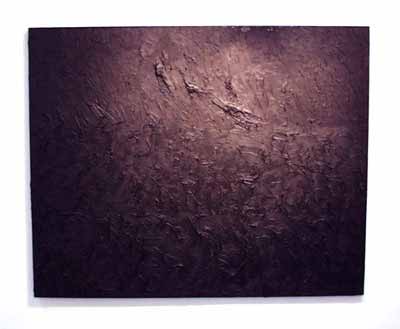

Biography

|
Essay Josť Bellver: Black Paintings by Fred Sigman Hung on the white walls of the gallery, Josť Bellver's Black Paintings speak in whispers rather than shouts. Even after a hundred years of abstract art among us, though, these paintings still perplex some viewers - as they should. They do not easily give up their meaning or reveal their content. For the artist, this is his intention. The Black Paintings, according to Bellver, were "born from a clean mind" in the early 1980s. Reflecting on, even dreaming of blackness, Bellver wanted to produce a body of work which could be "free from the narrative of images." That is, without apparent meaning. And this is what is different about this work compared to what he has become known for: these paintings tell no story. Bellver explains that the paintings are about memory, "going back and bringing forward" something which has remained buried for nearly twenty years. The most interesting images, says the artist, are the ones which we carry within our mind, laying dormant but ever-present. Perhaps, our mental images will never see the light of day, so to speak - they remain our private meditations. For Bellver, that day came last winter when he decided to produce these works specifically for this exhibition. The principal material used in these works is tar - that black, resinous fluid which is obtained by the destructive distillation of wood or coal. It is the same material used by Chinese artists to produce the ink sticks which are transformed by water to produce black landscapes on white paper or silk. For the Chinese painter, it was through the use of ink that the "hidden ideas in the mind" were brought forth; while "each brushstroke should be a living idea." (from the 17th century Mustard Seed Garden Manual of Painting). It is in this manner, also, that Bellver uses tar. The calligraphic stroke, so characteristic of Chinese landscape paintings, and evident in Bellver's Black Paintings, can be seen also in the work of Van Gogh, such as his black crows in Wheatfield with Crows. It is, in fact, with Van Gogh's final painting that Bellver compares his own "direction of strokes" in these works. The energy which pushed Van Gogh's hand across the surface of the canvas, says Bellver, motivates him as well. As Bellver compares his paintings to Van Gogh, it is tempting for us to do likewise with other artists, especially those who made use of black. There are the Suprematist Black Paintings (1915) of Malevich, who related his work to the Yoga Stra, seeking through his art, an intuition with "the infinite ocean of knowledge and power that lies behind mankind." It is the realm of imagination that Kandinsky also pointed to in his 1913 painting Black Lines. And, of course, there are the Black Paintings (1950s) of Ad Reinhardt, who likened his use of black as a call to prayer in a time of fading light. The Black Paintings by Bellver have the same quality that was appreciated by the Zen Tea Master when examining a ceramic tea bowl. Reflecting the aesthetic attributes known in Japanese as sabi and wabi, both paintings and pottery have the beauty of things imperfect; the beauty of things unconventional. And, like the other aesthetic quality known as yugen, both bring about in the viewer the sudden perception of something mysterious and strange - an unknown never to be discovered. What ties Bellver's paintings to the Asian arts of painting and tea bowls, and to the modern artists mentioned above is the recognition that art can serve a function which restores to us a consciousness of reality - a reminder of the here and now. The Black Paintings are not only meditative for the viewer but are also the result of one man's meditations. |